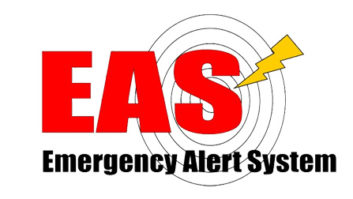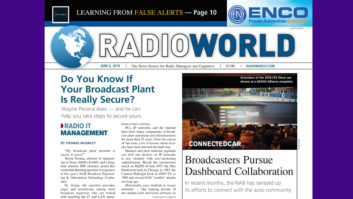After releasing a report about the January false ballistic missile alert in Hawaii, the Federal Communications Commission hosted a public roundtable in May to discuss lessons learned. Individuals from various emergency communications organizations participated.
Among them was Dennis Bookey, broadcast co-chair of the Alaska State Emergency Communications Committee, which recently had its own experience with a false alarm.

Radio World: What specifically was the focus of discussion?
Dennis Bookey: I was told Alaska was chosen to be included in the roundtable because it was a good example of what strong working relationships between public safety and broadcasters should look like. As planning advanced, my role was to contribute to the broadcast end of the system. My contribution was going to be on the reporting of false alerts to the FCC and if that should happen.
Our position on notifying the FCC of false alerts is supportive, provided [that such a system] in no way burdens any broadcaster and the goal is sharing information to benefit all EAS participants.
We want the FCC to understand that public safety officials and the SECCs have a great deal of parties to answer to right after such an event, and that the call or report to Washington isn’t at the top of the list. But just in the same way we learn from “best practices,” let’s learn from the things that go wrong.
Radio World: What are the emergency issues that your state has had to address within its EAS State Plan that are unique to Alaska?
Bookey: It’s all about tsunamis. We have an occasional Amber Alert and some local weather alerts the same as any other state, but our focus at the state level is all about tsunamis. It isn’t just a code listed in the plan. There are detailed explanations and diagrams for how that part of the system works.
We’re in an extremely active seismic region of the world. The National Tsunami Warning System is located just outside of Anchorage. The major cause of death from the ’64 earthquake was from the tsunami that followed.
Radio World: Did you learn anything in the discussions that might be useful to implement for Alaska?
Bookey: Yes. After Hawaii and our own recent false alert, I think it’s good that we have a part of our plan that addresses false alerts.
I don’t believe that necessarily means another EAS automatically goes out. Interrupting broadcasters’ airtime needs to be part of the evaluation. That should be [decided on] a case-by-case basis; but the plan should have the procedure documented and who is involved. We had actually started discussion of that process in our first meeting after the Hawaii FCC report came out.
Radio World: Alaska had its own false EAS alert recently surrounding a tsunami warning. There’s been some discussion that the problem lay with the message that was sent from a vendor in Florida to the state’s emergency communications network. Can you shed additional light on what happened?
Bookey: No one pushed the wrong button. On the morning of May 11, Alaska broadcast stations and cable systems carried one, and in some cases two, tsunami warnings that were actually a test sent by the National Tsunami Warning Center in Palmer.
So what happened? Because lives are at stake and every second counts, parts of the Alaska EAS system for tsunami warnings are automated. The Alaska EAS system uses a commercial vendor to supply an additional relay primarily for tsunami and Amber EAS activations. This system, EMNet, is hooked up to our 22 LP-1 stations, Alaska Rural Communications Service, Alaska Public Radio Network and some other key input points across the state. EMNet in turn is hooked up to the National Weather Service Weather Wire, which carries all the warnings and has to filter out the test.
In short, there was some coding contained within the vendor’s weather processing server that failed to recognize the tsunami warning as a test. This allowed the test to pass through to the LP-1s and be carried over the air and daisy-chained to all the stations and systems monitoring their LP-1s in the warned areas. This issue has been rectified.
Radio World: What has your organization learned that you might apply for future tests and alerts?
Bookey: The test that took place happens on a regular basis and is not intended for the EAS system. It’s for the NWS and many of the other components of a tsunami warning outside of the EAS environment. We did learn that our EMNet relay system can successfully send out a tsunami alert and warn the proper areas as a backup to NOAA weather radio. This reinforces the importance of the system in Alaska’s EAS plan. As stated before, we need to formalize the action steps in the case of a false alert.
We’ve learned a great deal from our most recent actual activation in January that has given us a wealth of information. All of the EAS partners involved in the tsunami warning took away lessons that are effecting changes. We learned how important it is to have multiple streams to broadcast and cable operators of the tsunami activation. NOAA weather radio is great. But it’s not enough. Weather alerts aren’t passed through IPAWS, so you need additional sources.
Our EMNet relay system takes on a more critical role as a redundancy. In addition we need to do a more detailed job of setting monitoring points especially with our coastal stations. We’ve also learned the timelines for wireless carrier’s plans for bringing WEA online, which we didn’t know prior to the event. Because WEA testing hasn’t officially been authorized yet, our activation revealed varying results with message distribution. We all need to learn where and on what devices a WEA alert is going to show up.
The public is hungry for this feedback; and we have limited information to give them at this point. WEA testing is critical. We hope to include WEA testing in our annual live code tsunami test next March.
Radio World: Why are roundtables like this important?
Bookey: There are different approaches to EAS across the country. It’s always beneficial when you’re exposed to different procedures, and it’s reassuring when you hear from areas that match your experiences.
In broadcasting, we’re all pretty well connected, and keep track of what everybody in our industry is doing; but our public safety exposure is most likely limited to those in our locality and state. I greatly appreciated hearing from the public safety officials involved in emergency planning on the panel, as they work well outside of our day-to-day world.
And let’s admit it. Those are the guys activating our transmitters. Hearing frank conversation from Patrick Sheehan of the Tennessee Emergency Management Agency was very enlightening. He was honest enough to admit what we already know: The system is imperfect and it involves humans and humans makes mistakes. There will be other false alerts.
Radio World: What else should we know?
Bookey: We’re all stuck with the technical restrictions of the EAS format. We have to find ways to make it work as best we can. This is one of the areas we rightfully take credit for serving the public good. I hear the line “EAS is broke” quite often. If you think EAS is broke, then get involved and make it better where you live.
Comment on this or any story. Email [email protected] with “Letter to the Editor” in the subject field.












